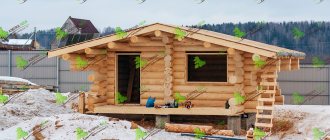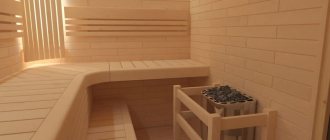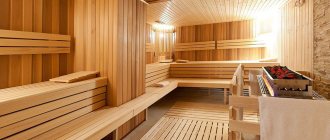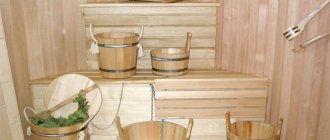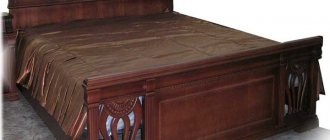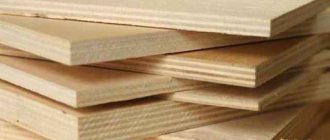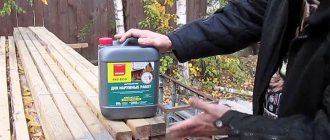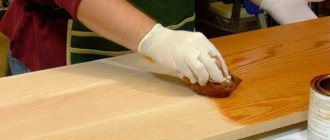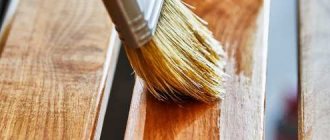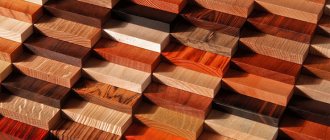Larch bathhouse
When choosing a material for a bathhouse, you need to take into account not only the heat capacity of wood, but also other characteristics. Unlike a residential building, the wood here is exposed to intense exposure to steam, water and temperature fluctuations, because the building is heated only during bathing. Not every material can withstand such a load.
An excellent option for a bathhouse is larch. The tree is a coniferous tree, meaning it contains a fairly large amount of resin. High resin content ensures amazing resistance of larch to rot, fungi, and water.
If the products are made of pine, it is necessary to varnish and protect them from moisture. Larch does not need this. On the contrary, over time it only becomes stronger than oak.
The advantages of wood are not limited to unique resistance to decay. Accordingly, a larch bathhouse will have the following features:
- strength - the density of larch is only slightly less than that of oak, a structure made from this tree will last a long time, as it is not subject to mechanical damage;
- resistance to rain, snow and heat ensures the longevity of the bath;
- larch lining includes a small number of knots, and this means not only aesthetics, but also greater strength of the boards and logs themselves;
- the wood has a beautiful texture and is very attractive;
- a log bathhouse made of larch does not require any protective measures; there is no need for periodic treatment with antiseptics, insect repellents, or stains;
- lining made from this material has the same advantages as logs.
There are also disadvantages to a bathhouse made of larch:
- it is at least 2 times more expensive than pine;
- wood is processed with some difficulty, so the bathhouse itself will also cost more.
Comment! Larch floors are still used in European castles. Its age reaches 300–400 years.
Materials used in construction
In construction and finishing works, wood is used in different forms. Often a log house, timber, lining and even slab or unedged board with bast are used. Each option has its own distinctive qualities. Let us consider in more detail which materials are most often used for the construction or finishing of a bathhouse structure.
timber
Often, linden timber or log frames are used for construction work. This material is very well suited for such manipulations
However, the master/builder should always pay attention to linden timber. The surface of the natural material must be perfectly clean, without cracks, chips or other inclusions
The shade of the products should be uniform, without spots or sharp color changes.
Very reliable and strong baths are built from timber. In this case, construction lumber is laid in layers, in crowns. Finished structures shrink after some time, but if the work is carried out correctly, this will not cause serious problems.
Lining
Lining is another popular material that is used in the construction of baths. Most often it is used as an internal finishing material or external cladding of a building. You can attach boards of different thicknesses.
Linden lining is classified into different classes. Let's look at each of them.
"Extra". This is the highest class. The “Extra” lining should not have a single defect or defect. The geometry of such planks is ideal, but they are also expensive.
Linden lining is an ideal material for finishing the bases in a steam room. Due to its healing properties when exposed to high temperatures, such cladding will have a particularly beneficial effect on the health of household members.
Aspen bathhouse: pros and cons
If larch is used both as the main material and as a finishing material for the steam room, then with aspen the situation is different. This tree is very specific and not cheap. Moreover, the cost is determined not by high qualities, but by the features of the workpiece.
Aspen grows in wetlands, which causes the inside of the trunk to rot. You can only harvest aspen tops up to 4–5 m in length. The rest of the tree is unusable and is simply thrown away. In addition, aspen harvesting is only possible from March to May, while aspen is relatively easy to process. This “seasonality” makes the collection and supply of material a very expensive endeavor.
And yet, this is the material that people often prefer to linden and alder. In fact, the disadvantages of aspen turn into advantages when it comes to the steam room:
- aspen - hardwood, boards or lining from it do not emit resin, which is a valuable quality for a sauna;
- wood does not heat up as much as many other species, this eliminates the possibility of burns;
- out of 3 trunks, only one turns out to be suitable for construction, but it is extremely resistant to moisture and does not rot;
- wet aspen is easy to process; when dried, it shrinks greatly, but at the same time the tree acquires exceptional strength.
An aspen bathhouse lasts for decades, and over time it only becomes stronger.
Important! Aspen wood is very wet and shrinks greatly when dried. However, once it dries, it becomes rock hard.
The secret of the right steam room
It is a woody plant in the form of large shrubs or trees. The linden material is homogeneous, with a beautiful shine and an unobtrusive honey aroma. Its conditional density is 400 kg/m3, in a dry state it reaches 495 kg/m3. Linden wood is soft, viscous, light. Its color is white or pale yellow, but there are varieties of pink or light brown.
The structure of the linden material is moderately expressed. Knots are found infrequently, and the annual layers are almost invisible. Due to the uniform distribution of moisture, such lumber is less susceptible to warping and cracking. Wear resistance is low, which is why the wood bends easily and can be polished and painted. Rodents do not like linden and do not spoil it. And since it retains heat well, it has always been used for the construction of baths and food warehouses.
Linden wood is an excellent material for interior decoration of a steam room, in which, thanks to it, a healing microclimate is created. It is durable, does not emit harmful substances and resins when heated, and regulates the level of humidity in the steam room. This lining can withstand temperatures up to 120°C, but due to its low thermal conductivity it does not burn the body.
Linden or aspen for a bath: which is better?
It's really difficult to choose between these two materials. Linden is traditionally considered the best tree for a bathhouse and deservedly so. However, aspen, despite its external ugliness, poses serious competition to it.
Linden wood is soft, it is easy to process, and accordingly, the construction of a bathhouse requires less cost. If dried logs were used, the building does not shrink and can be used immediately after completion of construction.
Aspen, on the contrary, is processed with great difficulty. Since a bathhouse requires well-dried material, this makes construction an expensive and time-consuming task.
The softness of linden is also its disadvantage - the tree is short-lived, but dry aspen acquires the hardness of stone and lasts an exceptionally long time. Linden does not need to be processed for aesthetic purposes; even an unsanded log looks great, not like lining. To give aspen an aesthetic appearance, you should trim the bark from the log, sand it and plan it. In addition, repeated grinding will be required - the latter is performed 3 years from the date of laying. Otherwise, instead of a silver-white bath, you get a gray, unsightly one with dark spots.
Linden is not resistant to rotting and fungal attack. The bathhouse requires periodic treatment with special preparations. Aspen is not susceptible to rot or fungi. The only treatment that may be needed is for wasps. For some reason, the latter really love this tree.
The cost of linden is higher than that of aspen, so it is really difficult to choose.
Important! A log house for a bathhouse made of aspen and linden, as confirmed by reviews from builders, does not require additional finishing of the steam room. Both breeds are certainly suitable for sauna lining.
How to distinguish linden from aspen
Lining made from linden and aspen is very easy to confuse. It is not so easy to distinguish wood.
First of all, pay attention to the color. The wood of linden lining is very light, but still has a coffee tint. Against its background, the aspen is almost snowy white.
Linden boards have a characteristic sweet aroma. The smell of aspen is bitter, more reminiscent of birch sap. Aspen lining is rarely truly smooth, since this wood is difficult to process, but linden is smooth and silky;
Knots in aspen lining are more common. They are darker and clearly visible. In category B, even falling knots are possible here.
To distinguish linden boards from aspen boards, you need to not only inspect them, but also try them by touch.
What is better in a steam room: aspen or linden
The choice between linden and aspen lining is even more difficult. The materials have a number of common properties that are very useful for saunas and steam rooms:
- both linden and aspen do not heat up as much as other types of wood;
- shelves and walls finished with clapboard remain pleasant to the touch and do not burn;
- the wood of both species releases aromatic oils that are beneficial to health;
- the lining looks equally aesthetically pleasing;
- Both linden and aspen tolerate steam well.
There are also differences between linden and aspen:
- the smell of linden wood is deservedly considered the most pleasant, while that of aspen is bitter and not everyone likes it;
- linden darkens over time, aspen practically does not change color;
- linden lining is susceptible to fungus, the finishing must be treated, but aspen does not have this drawback;
- linden costs almost 2 times more than aspen lining, but linden wood contains far fewer knots and stains and looks more beautiful.
For a steam room, linden or aspen linings are equally good. The choice determines the taste of the owner.
Usage
Is it possible to build an entire log house from linden? Why not? Nowadays everything is possible. But let’s take a separate look at what it would look like to log a bathhouse made of linden and the option of only finishing the bathhouse with linden in the form of a lining.
However, such an undertaking will require certain investments in protecting the bathhouse from the outside. The fact is that using linden for construction is not a very good idea - it is of little use as a wall material, since precipitation will quickly lead to the proliferation of fungi on it, which causes rotting.
To prevent this from happening, the outside of the log house will have to be thoroughly and often treated with antiseptics (those antiseptics that are sold for self-coating have an extremely shallow penetration depth - 2-3 mm), or impregnated (industrially impregnated wood) is needed, but this is not a fact. that you will find such a linden tree, and what’s the point - they will process the log there from all sides, but why do you need such happiness in the steam room?
ADVICE! The linden log house will have to be protected as a “UNESCO heritage”, so it is more practical to build it from pine, and decorate the steam room with linden clapboard.
Finishing
Wood finishing usually means lining walls and ceilings with lining. This is a common practice, and it is used not only in bathhouses made of brick or concrete, or in frame ones - the frame and timber are covered with clapboard. But this is done in two cases:
- when it turned out that the thickness of the log was chosen incorrectly and in winter the bathhouse needs additional insulation;
- when the walls of a steam room are made of coniferous wood and need to be insulated from heat so that the resin does not leak out (or at least does not fall on those steaming).
The lining can be sewn onto both “bare” walls (of course, through lathing and with film insulation), and on walls with insulation.
Often foil is stuffed under the lining as a heat-reflecting and vapor barrier layer. But this only makes sense in a steam room.
CONCLUSION! So, it is beneficial to use linden lining only in a steam room - it does not emit resin, it smells nice, it is light, and the price is reasonable. In other rooms, the decoration can be made of anything.
Cedar for a bath
Noble cedar wood belongs to the elite category. The material has exceptional qualities, not only functional, but also medicinal.
Cedar wood is impregnated with unusual resinous substances. They call it gum, emphasizing its special qualities. It has an antibacterial effect not only on the wood itself, but also on the environment. When heated, the substances begin to evaporate, disinfecting the room and relieving a person of a wide variety of diseases, so cedar is ideal for a steam room.
Important! In Siberia, a bathhouse decorated with cedar clapboard is recommended for those suffering from diseases of the respiratory system. The tree can even cure bronchial asthma.
Log bathhouse made of cedar
Cedar is the best option for a bath. The qualities of wood provide the log house with durability, beauty, and convenience:
- cedar has the lowest thermal conductivity compared to other conifers; a cedar bathhouse is warm even in the bitterest frosts;
- the wood is resinous, provides excellent antiseptic properties, therefore, it does not rot, is not susceptible to fungus, and even insects are not able to damage it;
- cedar resins are healing, cedar finishing provides an excellent antibacterial effect and natural air ionization;
- cedar is resistant to moisture and temperature changes. A cedar bathhouse is very durable and will last at least half a century;
- both the logs and the lining are very beautiful and do not need any processing: the natural color and texture are beyond praise.
There is only one drawback to cedar wood or lining - high cost.
Cedar lining for a bathhouse
Cedar lining for a bathhouse has all the advantages of a log. This material is ideal for a steam room, although it is not as effective as aspen:
- gum resin evaporates, but does not release when heated, so cedar lining does not burn and does not leave resinous stains;
- cedar lining guarantees an excellent healing effect;
- the specific fibrous structure of the wood ensures the absence of cracks and chips even at the ends;
- the lining is very beautiful: the colors are even, muted, the knots are small, the panels are smooth and delicate to the touch;
- the material is not afraid of moisture, steam, mold, or rotting, so it does not need any processing.
Important! Over time, cedar lining darkens, or rather, acquires a brownish tint.
Cedar bath: photo
Cedar is an excellent building material and allows you to implement any project - from a traditional Russian bathhouse to a complex hotel complex.
Finishing with paired cedar lining is no less impressive and beautiful and is suitable for any style.
Requirements for lining for the steam room and living room
Of course, since the living room in the bathhouse, steam room and washing room are characterized by different temperature and humidity conditions, the requirements for the cladding material are somewhat different. If a steam room requires lining with low thermal conductivity and resistance to high humidity and temperature, then for lining a living room, aesthetic qualities, cost and service life come first.
So, the most important requirements for the material for covering a steam room:
- Environmental friendliness. At high temperatures, all substances contained in the material are released into the steam room air. Therefore, plastic panels in the steam room are unacceptable, therefore antiseptics are not used in the steam room.
- Low thermal conductivity. The lower it is, the lower the risk of getting burned by leaning against the wall, and the lower the heat loss in the bathhouse.
- High resistance to water.
- Beauty.
- Reasonable cost
Alder for a bath
Another traditional material is gray and black alder for the bathhouse. The wood of these species has a very unusual porous structure. This feature makes alder lining a suitable option for a bathhouse:
- gray and black alder practically does not shrink. Due to its high porosity, moisture evaporates very quickly, this quality makes the lining an extremely suitable solution for a steam room;
- the wood is soft, easy to process at any stage, so the construction of an alder bathhouse will not require large expenses;
- sauna lining made of alder does not warp or deform even after several decades;
- wonderfully beautiful shades - from fiery to brick, give the building real beauty;
- In the dressing room, it is recommended to open the lining with wax to emphasize the color and texture.
However, judging by the reviews, alder for baths also has serious disadvantages.
- Wood is not very resistant to water. On the one hand, in the steam room moisture evaporates from the pores, and this is a plus. However, at low temperatures it stagnates in the pores and causes rotting. The external side of the log house requires periodic processing.
- Over time, the alder darkens almost to black.
- The cost of the lining is quite significant. The fact is that alder wood includes many knots. To get rid of them, a very thick layer of wood is cut from the trunk. In this case, the whips are short, and the material is expensive.
- The alder bathhouse needs insulation: there are too many joints.
Alder baths are built in mid-latitudes, where there is no need to insulate it.
Classic lining, eurolining, calm.
Classic lining
Regular or classic lining is distinguished by thin narrow strips; the chamfers of classic lining are straight.
Eurolining
This type of material has heavier and wider boards, which are of great interest in the design of different rooms and have exactly the same characteristics as thin material. The chamfers are rounded, the tenon is shorter and thicker.
Calm
This lining is even thicker, stronger and more expensive, the tenon is longer than that of the Euro lining, but the chamfers are rounded.
Due to the fact that there are cuts on the back side of the boards, the lining lasts longer and does not warp over time - the cuts relieve stress in the board that occurs during drying
Important! When purchasing lining for a steam room, please note that there should be no knots. It is the knots that heat up the fastest and can cause burns. In addition, they may fall out!
Reviews
Boris Nevelov, 42 years old, Novosibirsk
I hesitated for a long time between linden and aspen, but in the end I made the traditional choice: linden. It costs more, but for a steam room, I think, you won’t find a better one. The wood is warm, silky, and does not heat up. And the smell in the steam room will make you pumped.
Nikolay Morozov, 35 years old, Omsk
There used to be a bathhouse on the site - made of pine. The inside of the steam room was lined with linden. But something went wrong: it began to rot. And in the bathhouse there was always mold or something else. They dismantled and built a new one - from aspen. It has been standing for more than 6 years, nothing rots, there is no trace of fungus. But, of course, it took me a long time to choose a tree. I went to the base three times to take away the barrels.
Alexander Fedorov, 52 years old, Ufa
A bathhouse was started on the site as soon as the house began to be built. I chose aspen: the price is lower than cedar, and it is not afraid of water, if it is good. Banya is already 15 years old. The color, of course, is not the same, it has become gray, but the tree is like stone. During all this time there was never mold in either the steam room or the dressing room.
Recommended Posts
Bathhouse made from a sea container
Bathhouse made from sleepers
Sauna tent
Do-it-yourself bathhouse repair
Russian wood-fired sauna
Why is there no draft in the sauna stove?
What types of wood are used
Coniferous and deciduous wood can be used to make lining. The initial characteristics of each grade will affect the final properties of the finished material:
- price;
- possibility of subsequent processing;
- drying rate;
- moisture permeability;
- aesthetic properties and indicators;
- service life;
- thermal conductivity index.
Provided that the raw materials used do not meet the necessary requirements, then even if the most professional and technologically advanced processing methods are used, the lining will not give the required characteristics.
How to choose the best finishing material
In order to cover the interior spaces located in a sauna or bathhouse, you should choose lining made from cedar, aspen, alder or linden. The latter type is not afraid of moisture, since the surface of the linden lining will not be covered with rot. The surface has a creamy tint, and the material has a light honey aroma, which manifests itself during the heating process. It has virtually no knots, which facilitates subsequent processing. Linden aroma promotes the healing of liver cells, and is also used in anti-cellulite therapy. It helps to lift the mood, increasing a person’s internal energy, and replenishes lost strength. For a sauna this type of lining is preferable.
If the choice fell on alder paneling, the steam room will have a light pink tint. The material is classified as waterproof. Previously used in the construction of piers and wells. The structure of the material makes alder lining incredibly durable. The material is not afraid of chips and other consequences of mechanical impact.
Even a small knot can subsequently lead to serious burns, so when choosing a material, special attention is paid to the quality of the purchased product. Helps improve the general condition of visitors, helps in the fight against diseases associated with joints
The aroma of wood is slightly bitter, but has an anthelmintic and anti-inflammatory effect. Aspen was popularly valued for its ability to kill vampires. Helps remove negative energy.
Pine lining is also suitable for a steam room, but provided that the temperature in the room does not reach 100°C. Otherwise, drops of resin will appear on the surface of the lining. The breed does not tolerate moisture well, as well as significant temperature changes. Over time, the material will lose its external gloss and shape. Cedar lining belongs to the category of expensive finishing materials, but the price will be fully justified over time. The aroma of cedar wood is memorable, and the material itself can withstand high temperatures. Wood is considered useful. It is much more comfortable to breathe in a room lined with this type of lining.
Cedar pine is found more often in display cases. The quality of this material differs from its analogue. In the process of strong heating, the material will begin to cry resin tears, the thermal conductivity index is higher, the surface heats up quickly, which leads to injuries. Breathing air enriched with resins is difficult. There are different colors.
Classification of wood by grade
Having examined in more detail the characteristics of each of the breeds, it is necessary to clarify such an important aspect as dividing products into grades, focusing on the types of profiles used. The production technology for lining is the same for all types of wood. The sorting of boards can be influenced by some external characteristics, which are taken into account when packaging the finished product and affect the cost indicator.
There are several classes:
- Grade “A”, “B”, “C”. Small defects may be observed on the outside of the product. Such nuances are identified even at the stage of packaging of finished products. Class “C” material is considered to be of less quality, the cost of which is more affordable. Used in areas that are hidden from view or rarely noticeable.
- Extra or premium class. Such materials are considered to be of the highest quality. Chips, knots and other defects are completely absent. The absence of external defects is reflected in the cost of the material. Can be used when arranging surfaces of any type. Used for making shelves or ceiling cladding to save money.
Similar wood blanks differ in profile. I distinguish between calm, soft-line, eurolining and others.
Video description
Video material will help you choose the mounting option for the lining
Installation of sheathing
The installation of the lathing allows not only to secure the lining, but also to insulate the bathhouse. This primed block structure is also designed to allow air circulation under the finish. Thanks to the movement of air masses, the inside of the finishing material will dry quickly. The free space will still allow condensation to drain freely. Therefore, the likelihood of mold, rot, and fungus will decrease.
In addition, the sheathing under the lining in a bathhouse in a steam room or in another room allows for electrical wiring. It is necessary both for lighting and for installing sockets.
Installation of steam room sheathing Source sibdok.ru
Internal insulation under the lining
At the beginning of work, waterproofing is fixed to the walls. It is nailed or pressed against the sheathing bars. Mineral wool slabs are mainly used as a heat insulator. The insulating material is installed in the empty sections of the sheathing.
Next, the thermal insulation material together with the frame is covered with a vapor barrier. At this stage, foil material is used as it is able to reflect heat. The vapor barrier is laid with an overlap. Specialists must glue the joints with aluminum tape.
Narrow slats with a maximum thickness of 20 mm are fixed on top of the vapor barrier. Thanks to their use, a ventilation gap is created between the foil and the finishing lumber.
Which material to choose: whole log or timber
Baths are built from both solid logs and timber. Material for construction, as a rule, is prepared seasonally using all methods at once: logs and beams, after drying it in a special chamber. Logs have high humidity, up to 85%, which greatly increases drying costs. After drying, the material loses density and shrinks in size, which also affects the price and, as a consequence, the choice during construction. Even more effort and money are spent on the production of timber, the price will be higher than that of logs. The quality remains at the same level.
Therefore, it is best to choose ready-made, high-quality logs for building a bathhouse, the main thing is that they are not subject to internal rot and do not lose their properties due to improper drying.
What to process
The shelves are located in the steam room, which means it is hot and humid there during procedures. This places significant restrictions on what wood protection products can be used.
Since we have a rather extensive article devoted to all the means the use of which is permissible in a steam room, here we will limit ourselves to only a brief summary of the essence of the issue.
So, how to treat the shelves in a linden bath? It depends on the purpose - it is treated both as a treatment for an already established problem, and as a preventive measure.
Since we are talking about a steam room, all preventive measures are limited to protection from water, but this is quite acceptable protection - if there is no moisture or air, then the mushrooms will not be able to reproduce normally; for this they need three components: water, air and wood.
Oils, waxes and oil waxes protect from moisture. All of them are made from natural ingredients - linseed oil, for example, and also from beeswax. You can buy them in a store, or make them yourself.
The result is the same: a waterproof film is formed on the surface, which clogs the pores of the wood, preventing moisture from penetrating into the inner layers.
IMPORTANT! Such film is short-lived and requires renewal.
If the shelves have darkened, then you first need to correct the situation. In principle, both in case of infection with fungi and when darkening simply occurs, you can use the same product - this is “Belizna” bleach, that is, a solution of sodium hypochlorite in water.
It simultaneously returns the natural color to the tree, kills many different types of bacteria, and most importantly, fungi, for example, those that cause blue discoloration.
ADVICE! Mold should be combated with boric acid or borax, not bleach.
Bleach will not cause any harm because the chlorine disappears quickly. But you can simply remove the darkening with sandpaper or a sander.
Actually caring for linden, if it differs from caring for other types of wood, is only in the direction of greater care, more frequent inspections and the priority of preventive measures.
By the way, here is our other article dedicated to the impregnation of regiments.
In general, you can read about bath furniture here.
We will separately mention benches: their designs and a separate article on self-production.
The same goes for the benches – designs and manufacturing.
About insulation
A layer of insulation should be laid between the wall and the finishing lining. This will help avoid heat loss, drafts and accumulation of dampness on the walls of the room. The market offers a wide range of such products.
Mineral wool must be excluded immediately - indoors, and even more so for baths it cannot be used. It would be most reasonable to insulate the walls in the bathhouse with foil isover, or a regular reflector for radiators on a foam rubber base.
Isover insulation option
You can also use natural insulation materials (reeds, sedge), but then they will require additional processing to increase their fire resistance.
Any insulation for a bath should:
- be as environmentally friendly as possible;
- do not contribute to the proliferation of pathogenic fungi and bacteria;
- resistant to moisture and deformation;
- have a high thermal conductivity coefficient.
